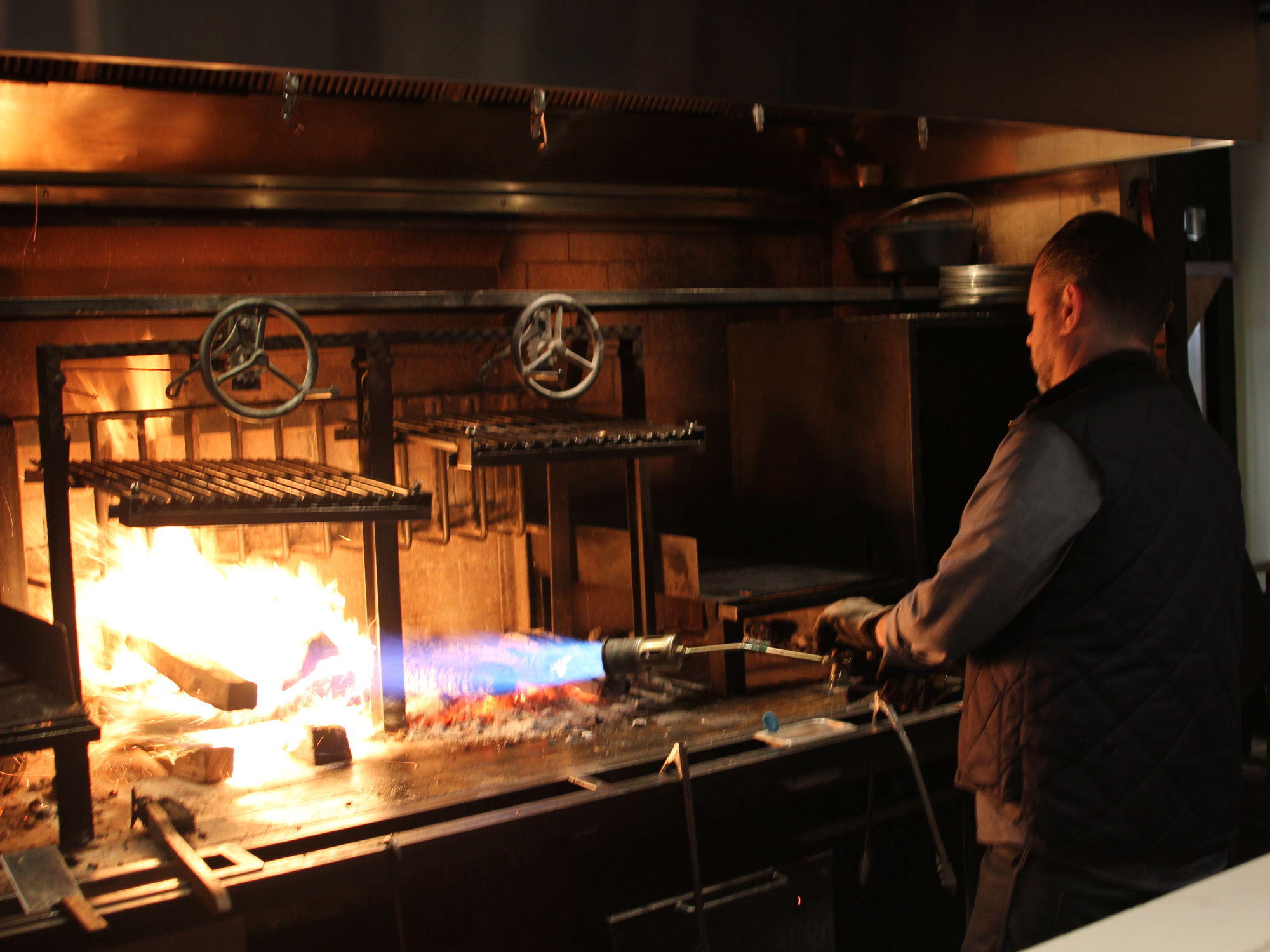YEMEN SITS AT THE SOUTHERN END—the heel—of the Arabian peninsula, next to Oman, opposite Eritrea and Somalia in Africa. It is safe to say that it is not a country that occupies the thoughts of most Chicagoans, unless something happens—like the two things that happened in the last few weeks, a botched raid on an al-Qaeda encampment in a remote part of the country (we’ve been at war there for a while) and the blocking of immigrants from seven Muslim-majority countries in that part of the world, Yemen among them.
But if like me, you note the presence of other cultures in Chicago by their restaurants, Yemen has started to make its presence known on the northwest side. Two Yemeni restaurants popped up on Elston in the last couple of years, and I learned of a third when Keng Sisivath, creator of the Strange Foods Chicago Festival, invited me to Mandi Noor in a strip mall on west Lawrence to record a podcast with friends of his, while eating sitting cross-legged on a carpet, off a platter piled with rice and meats.
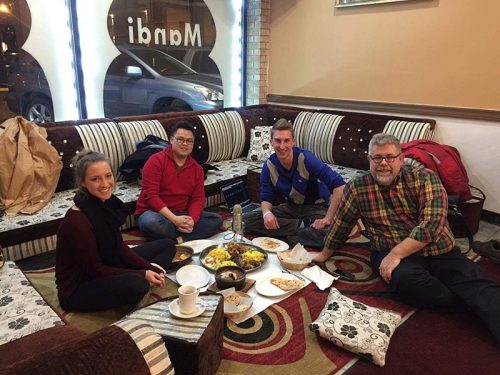 Courtesy Keng Sisavath
Courtesy Keng Sisavath Monica Sapozhnikov (Chicagofoodevents), Keng Sisavath, Jeffrey Lamp (Triple F Podcast), and the author
I had never actually been to any of the Yemeni restaurants, suspecting that the food would be plain, less sophisticated and certainly less interestingly seasoned than that of more cosmopolitan places like Lebanon or Jordan. There’s a long stretch in that part of the world that mainly eats lamb and rice, prepared pretty basically.
So I was surprised at the variety of flavors that our feast on the floor offered—curry spices that suggested Yemen’s place on trade routes between India and Ethiopia, rice pilaf that had a meaty taste like Indian biryani compared to the fluffy but bland Persian pilafs, and in a stew called fahsa, a bitter but intriguing spice profile I couldn’t place. Also interesting was the Yemeni bread we got with the second round we ordered—a flaky layered bread that shattered like baklava as we used it to scoop up the fahsa.
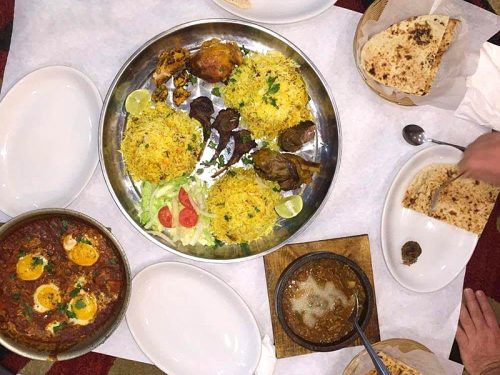 Keng Sisavath
Keng Sisavath Center: lamb chops, mandi lamb and mandi chicken with rice; lower left shakshuka, lower right, lamb fahsa; “Arabic bread”
I realized that there was more to Yemeni cuisine than I’d ever suspected. And also that there might be more to the cooks behind this restaurant than others, too.
Gallery: “Every home makes this bread”
I RETURNED ON SATURDAY NIGHT TO FIND the restaurant, which had been empty when we ate on the carpet, nearly full to capacity. Four men sat on the floor where we’d sat, having tea, while one long table in the center was full with a party (again, all-male) loudly and busily conversing and drinking cans of Pepsi, the bright blue metal of the can standing out incongruously when everything else at the table—the food, the faces, the middle eastern hospitality—could have come from decades ago.
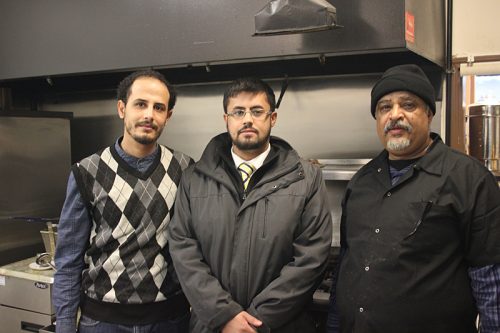
Yaser Saeed, Alaa Abdulla, and owner Mohamed Saeed
The kitchen was visible through a window behind the cashier, and it too was busy with activity that night as they tried to keep up with the table of about 20, plus carry out orders. The owner, Mohamed Saeed, a stocky man with a salt-and-pepper goatee, worked over things burbling in pots on the grill, while his son Yaser Saeed, with whom I had talked to arrange an interview, flipped pitas on the grill and piled rice on platters.
It did not look like a very good time to interrupt anybody for an interview, but they had brought in an extra family member, Mohamed’s nephew Alaa Abdulla, to explain Yemeni food to me as they worked. He doesn’t work in the restaurant—he’s a limo driver—but he had the best English for explaining Yemeni cuisine to me.
“My uncle cooked in his backyard, and everybody loved his food,” Alaa explained. “So he decided to open a restaurant for the Yemeni people here.”
I wasn’t sure at first how much of this Mohamed himself understood, but he clearly followed at least the outline of the conversation, because he pulled his phone out of his pocket and told Alaa to show me something. After a little wrangling with passwords, Alaa pulled up a video of Mohamed’s backyard grill. It was like a tandoor, a big concrete cone, with coals at the bottom, and a circular grate like you might find on a Weber grill, on top of which there was a square pan of cloudy water. I saw another grill being set down on top of the pan—and then Mohamed started laying hunks of lamb, smeared with colorful spices, on this second grill.
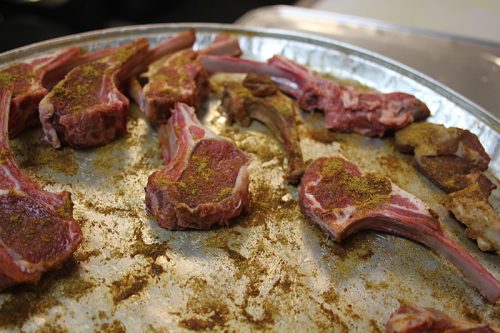
Lamb chops, dusted with spices and destined for the grill
“This is the rice,” Alaa said, pointing to the square pan. “The lamb sits on top of it, and the juices drip into the rice so it has plenty of flavor.” That explained why the rice pilaf had a richer, certainly meatier, taste than you typically found in middle eastern restaurants.
“So he started in his backyard and then opened a restaurant, like all the great barbecue guys,” I said. Mohamed understood that, because he nodded at me, grinning.
Alaa led me around to the other side of the stove to show me a tall metal box with a temperature dial set in its door. “He can’t have a grill like that in the restaurant, of course, so he bought this. He puts the rice down here,” he said, pointing to the base, “and the lamb hangs in here, dripping into the rice. So you get the same flavor.”
“How long has he been in America?” I asked.
A quick back and forth. “26 years,” Alaa answered.
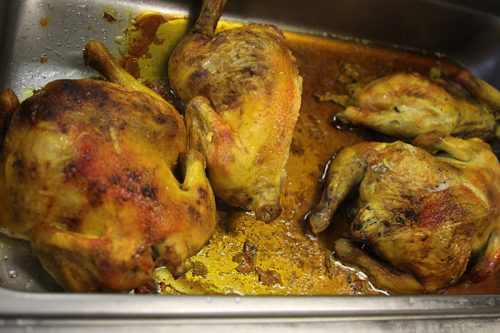
Mandi chicken
A series of warming pans sat at the edge of the workspace, and Yaser quickly lifted the lids to show me the foods kept inside them—rice, brightly spiced lamb chops, and the signature dishes, mandi chicken and lamb, both roasted meats coated with the same mix of coriander, cumin, turmeric and other spices. There’s a long printed menu, but I was quickly learning that the dishes that really mattered to Yemenis made a short list. At the stove, Mohamed stirred a skillet full of onions, and I asked what dish that was. “He’s making more rice,” Alaa explained. “This won’t have the lamb drippings in it, but the onions will give it some flavor. They’ve only been open a couple of months, so you don’t know how busy it’s going to be. Tonight is very busy, so they’re running out of rice.”
I watched as Mohamed stirred the skillet, then dumped its contents into a big round pan, stirring up the rice which had been yellowed with saffron. “So where do most of the Yemenis in Chicago live?” I asked. “In this area?”
“Many middle eastern people from other countries come to eat Yemen food, because it’s all very healthy.”
“Some,” Alaa said. “But many of them move to the south side, Bridgeview and Chicago Ridge.”
“What do Yemenis do in Chicago? Do they drive cabs, or do computers, or…”
“All kinds of jobs,” Alaa said. “But mostly, they’re business owners, entrepreneurs. Most of those guys,” he said, waving toward the dining room, “they have small businesses, like shops or gas stations. Some work in IT. We do all kinds of jobs.”
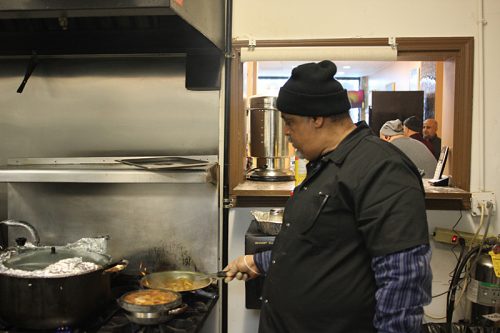
NEXT MOHAMED POURED A YELLOWISH broth into a thick-walled bowl, which looked like—or considering the neighborhood, probably was—the kind Koreans use for dolsot bibimbap. That helped explain why the fahsa, when it came to our table (or rather, our carpet on the floor), bubbled so volcanically for the first few minutes. He added chunks of lamb and some slices of okra, then stirred it together as the vegetables broke down. Fahsa, when it arrives at your table or carpet, is topped with a grayish-white, not entirely appetizing-looking slurry which has set somewhat as it boils. Stirred in, though, it gives it its unusual flavor. “What’s the stuff on top?” I asked.
Alaa grabbed a jar full of a granular powder, about the size of wheat germ. “Fenugreek,” he said. “Mixed with water. It’s very healthy for you. All the food is made from scratch. It’s very healthy for you. Many middle eastern people from other countries come to eat Yemen food, because it’s all very healthy.”

Fahsa bubbling on the stove.
In the back of the room a woman named Ryma Ladmin had been working on her own, and at that point she gestured to Alaa. “She wants to show you how the Yemen bread is made,” he said. She had set out three powders in measuring cups, like a demonstration on TV. “Every family makes this,” Alaa said. “It’s just white flour, wheat flour, a little milk powder, water and some salt. Some people add egg, but we don’t. Then you roll it out and fold it over.”
Ryma demonstrated the rolling out on a square of dough that had already been folded into several layers. When it was done, she set it on the grill, pressing it down with the same handled weight a diner cook uses to keep bacon from curling. “Do you make the Arabic bread, too?” I asked, using the name they used for the large pitas.
“No, we buy those,” Alaa answered. “But every home in Yemen makes this bread. Every home,” he said.
Dishes continued going out of the kitchen, these same favorite dishes over and over, but Alaa kept finding more things to show me. Like chitney, which looks like the traditional coriander chutney in Indian restaurants but is made quite differently—green tomatoes, hot pepper, garlic and cilantro, as close to chimmichurri as it is to coriander chutney. Even as I was leaving with a takeout order for home, he found another item for me to take—halwa, their version of the middle eastern sweet, orange with saffron and tasting something like peanut butter. (The kids were evenly split on it, but they fought over the Yemeni bread.)
The last few weeks have been so contentious with politics on social media, that I’ve wondered if anyone cared enough to read about something seemingly trivial like food. But if we’re worked up about immigration, then it seems like part of the point of immigration is the presence of a restaurant like this. I don’t mean that being here makes it their duty to entertain and educate me. I mean that it’s kind of my duty to take advantage of this opportunity to understand who they are and what they’re doing here. A restaurant as welcoming and full of new experiences as this is a new culture’s opening to the rest of us here. Now in particular, we should take it.
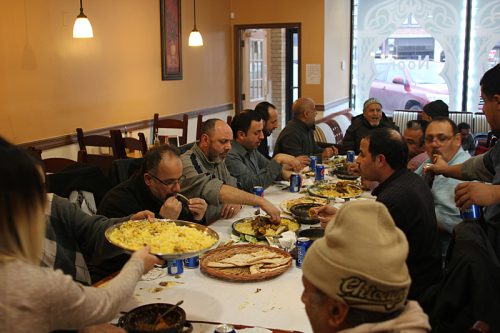
Michael Gebert makes it from scratch as editor of Fooditor.
Latest
Join the Discussion
After you comment, click Post. If you're not already logged in you will be asked to log in or register with Disqus.










